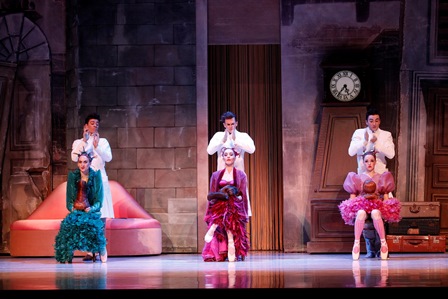Like most arts companies around the world, the Australian Ballet is offering audiences a streaming service during the COVID-19 lockdown. Each performance is available for a short time only, and Alexei Ratmansky’s Cinderella, first seen in Australia in 2013, is the second offering on the program. The cast is led by Lana Jones and Daniel Gaudiello in a partnership that is both moving and elegant. The performance was filmed in Brisbane in 2016.*
This Cinderella is not the usual take on the old fairy tale, although the characters from that fairy tale are present, albeit often in something of a new guise. For the most part the story also follows the narrative of a young girl being brought up in less than agreeable circumstances who finds love after attending a ball, and who then goes through the process of waiting for her Prince to find her after she leaves the ball in a hurry.
The unusual characteristics of Ratmansky’s version were made all the more powerful given that I had, the day before, watched Royal New Zealand Ballet’s streaming of Christopher Hampson’s Cinderella created originally for the New Zealand company in 2007. Hampson’s production had some lovely moments—a moving prologue, for example, in which we witnessed a young Cinderella at her mother’s funeral. It set a context for the rest of the story. There were some exceptional performances too including Jon Trimmer’s brilliant portrayal of the Royal Shoemaker who attempts to discover the inherent qualities of the shoe left behind at the ball by Cinderella.
But choreographically Hampson’s work was not especially inventive and fell within a very traditional balletic mode. Ratmansky’s choreography was still classically based but there was a distinctive touch to it. For a start, there were fewer easily recognisable classroom-style steps, and a much freer use of the arms and upper body.
In addition to this distinctive choreographic vocabulary, I was struck in particular by Ratmansky’s approach to the relationship between his vocabulary and Prokofiev’s score. Watching his choreography made the score sound quite different from what I had heard while watching the Hampson production. Ratmansky appeared to be strongly motivated by the music, more so than Hampson it seemed to me, and created steps specifically to match passages, even notes, in the score. This is not to say that Hampson’s choreography was unmusical, just that for Ratmansky music seemed to be the major force in the development of his movement.
I have reviewed the Ratmansky Cinderella elsewhere on this website so don’t intend to go further into the production. Here is a link to my original review. There is a place for both a traditional production, such as Hampson gives us, and a production that moves in a different direction. The same holds for Nutcracker, Swan Lake and others of the classics. But I loved being able to see the Hampson and the Ratmansky Cinderella side by side. It opened my eyes to an aspect of Ratmansky’s work that I hadn’t noticed in such depth before.
Michelle Potter, 23 April 2020
*For copyright reasons the Australian Ballet’s streamed performances are available to viewers in Australia only.
Featured image: Cinderella’s step-mother and step-sisters prepare for the ball in Alexei Ratmansky’s Cinderella. The Australia Ballet, 2013. Photo: © Jeff Busby
